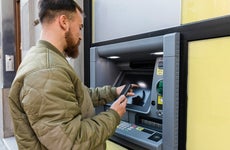Click to Pay: What it is, how it works

The Bankrate promise
At Bankrate we strive to help you make smarter financial decisions. While we adhere to strict , this post may contain references to products from our partners. Here's an explanation for . The content on this page is accurate as of the posting date; however, some of the offers mentioned may have expired. Terms apply to the offers listed on this page. Any opinions, analyses, reviews or recommendations expressed in this article are those of the author’s alone, and have not been reviewed, approved or otherwise endorsed by any card issuer.
Online shopping is already convenient. But the Click to Pay service introduced in late 2019 by Visa, American Express, Mastercard and Discover has made online shopping for everything from clothing and shoes to camping supplies and flowers even simpler.
Is Click to Pay a good option for you? Maybe. It depends on how important speedier online transactions are to you and if you have the self-control necessary to avoid overspending when purchases are just a click away. Usability is another factor to consider: Despite its 2020 release, Click to Pay still isn’t a checkout option with most merchants.
What is Click to Pay?
As its name suggests, Click to Pay allows you to purchase items from online retailers and service providers by clicking just one button. You can then choose from a list of credit and debit cards that you’ve already saved through Click to Pay to complete the purchase.
The goal here is speed: You won’t have to manually type in your credit card information with every purchase. You’ll only have to select the Click to Pay button and choose the pre-saved card you want to use. Click to Pay then provides the online merchant with the information it needs to close the sale.
Security is high, too. Your credit card information is never shared with merchants and never leaves the Click to Pay system. This is a secure way to pay, and makes it more difficult for scammers to steal your credit card information.
How does Click to Pay work?
To use Click to Pay, you’ll first have to sign up for the service and add your credit cards to your account. To do this, log onto Click to Pay from any of the major card networks: Visa, Mastercard, Discover and American Express.
Once you log into one of these sites, you’ll be asked to enter the information from any cards you want to enroll in Click to Pay. Then, if you see the Click to Pay logo on any retailer’s website — usually followed by the Discover, American Express, Visa and Mastercard logos — you simply click on that button.
Once you do, you’ll receive a six-digit security code on your phone or other device. You then enter that security code to access Click to Pay. The final step? You choose whichever of the linked credit cards you’d like to use to complete your purchase.
That’s right: You won’t have to memorize a password to use your cards with Click to Pay. You’ll instead rely on the unique security code that Click to Pay sends over.
Andrew Hopkins, senior vice president of global products at Discover, said that services such as Click to Pay will only get more important as consumers spend even more time shopping online.
Ecommerce was already booming before the COVID-19 pandemic shut down retailers in recent years and persuaded many nervous consumers to switch from in-person shopping to online purchases. The one-click option is just the latest example of card providers tweaking the online shopping experience, Hopkins said.
“Whenever we can remove friction in the checkout process, it’s a win for customers and merchants,” Hopkins said.
How does Click to Pay differ from Visa Checkout, American Express Checkout and Masterpass?
Click to Pay is similar to the online shopping buttons you might be used to from companies like Visa and American Express. The big difference? Click to Pay replaces these individual options with one standardized system.
Now that Click to Pay is available, Visa Checkout, American Express Checkout and Masterpass — the one-click shopping options offered previously by credit card networks — are gone. If you want to buy items online with one click, you must use Click to Pay.
Fortunately, if you’ve used Masterpass, Visa Checkout or American Express Checkout, then you’re already familiar with how Click to Pay works. And if you haven’t? Click to Pay is an intuitive system. It’s designed to be easy to use.
Benefits of Click to Pay
If you do most of your shopping online, connecting one of the best credit cards for online shopping with Click to Pay can make your shopping and rewards-earning strategy seamless.
Judy Nguyen, vice president of network product development with American Express, says seamlessness is a huge win for consumers. Nguyen points to an American Express survey of U.S. consumers in 2019: 85 percent of respondents said they had recently left items in their online shopping carts and not completed transactions once they got to a site’s checkout page. The biggest reasons for this? Nguyen said that consumers worried that because they had to enter so much additional information on the retailer’s site that their payments would not be secure. Others said that the checkout process was too long.
“Click to Pay helps to address all these pain points,” Nguyen said.
- Simplicity — Customers using Click to Pay no longer need to repeatedly enter their card, shipping and billing information when making purchases through websites and apps.
- Security — Merchants and service providers no longer need to store sensitive card information. That reduces the technology burden for merchants while also providing a safer checkout process for consumers, she said.
And it’s not just a win for shoppers. American Express surveyed U.S. merchants in 2020 and found that 70 percent of merchants who accept online payments agree that their online checkout experience needs to be simplified for consumers. The survey also found that 69 percent of merchants who accept online payments say they would prefer not to have to store customer credit cards on file. Not having to do this would reduce their costs and ease their security concerns, they said.
“Increased ecommerce during the COVID-19 pandemic has certainly also demonstrated that there’s a need for a better online checkout experience, for everyone involved,” Nguyen said.
Is Click to Pay a safe way to shop online?
Click to Pay transactions are secure, largely thanks to tokenization. When you buy something with the Click to Pay feature, your credit card information is turned into an encrypted, virtual card number that is unique to that specific transaction. It’s much easier for a criminal to steal your credit card number when you enter it into a website than it is for the same scammer to crack your personal financial information when it’s been tokenized.
When you make a purchase through Click to Pay, then, merchants never receive your credit card number. That adds a layer of protection.
Click to Pay also uses two-factor authentication to boost security. When you click on the Click to Pay logo, you’ll be sent a verification code. You won’t be able to close your transaction without entering that code on the Click to Pay screen.
While Click to Pay might be secure, that doesn’t mean it can’t cause financial harm to consumers. Convenience is a double-edged sword: with a way to make purchases almost instantaneously, it’s easier to give in to impulse buying and blow your budget.
The bottom line
Though acceptance is still relatively low, more merchants may offer the Click to Pay option on their websites. The number changes regularly, but Mastercard said in June 2020 that more than 10,000 merchants had enabled Click to Pay on their sites. This included such retailers as Expedia, Saks Fifth Avenue, Crate & Barrel and many others.
Click to Pay, then, makes it easier for consumers to buy at an increasingly large number of online retailers. This is good for convenience and, considering how safe transactions through the service are, for security. But be careful: Spending with the Click to Pay button is easy. Don’t let that simplicity lull you into overspending and running up too much debt on your credit card.
Related Articles

What is a cashier’s check? Definitions, uses, how to buy one, cost and alternatives


